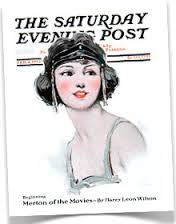
This section deals with the period that continues America's transition to a leading position in the world power structure. The industrial power of America's rise in the late 19th and early 20th centuries was the underpinning for America's growing dominance in international affairs. America's acquisition of an empire at the end of the Spanish-American war placed the nation in a new relationship with other nations, especially Japan. Our participation in the Great War was another step in the transition. America, however, had always been a reluctant participant in world affairs; separated from the other major nations of the world by two oceans, the feeling of being separate, even if unequal, prevailed.
The Twenties tended to reinforce that feeling of separateness among Americans. Following the Great War, the United States turned inward as her citizens reckoned the costs of that terrible conflict. The Twenties also saw substantial changes in domestic American life, as Victorian society was replaced by the age of the flapper. The twenties stand apart from other periods in American history, as they belong  to neither the past nor the future of the country. Many Americans lived high, and those that the Lorenz of the economic spectrum were able to see possibilities for the future. Marvelous new inventions and means of communication open new vistas even for people in remote corners of the United States. For a time everything seemed to be pointing skyward.
to neither the past nor the future of the country. Many Americans lived high, and those that the Lorenz of the economic spectrum were able to see possibilities for the future. Marvelous new inventions and means of communication open new vistas even for people in remote corners of the United States. For a time everything seemed to be pointing skyward.
It was the age of great sports figures: Babe Ruth, Ty Cobb, Lou Gehrig, Red Grange, Knute Rockne, Helen Wills, Bill Tilden, Bobby Jones, Walter Hagen, Jack Dempsey, among others. Charles Lindbergh flew solo across the Atlantic from New York to Paris, and in the process became a hero—almost overnight he went from obscurity to being the most famous man in the world. Then, at the end of that raucous decade, the crash of the stock market helped trigger the worst depression in America's history.
As the United States struggled to regain her economic footing, she went through a period of self-imposed detachment from the affairs of the rest of the world. As it had been for much of American history, the rest of the world seemed irrelevant. That position of national individualism, if not outright isolationism, was bound to change. The 20th century would become known as the "American Century," and by 1940 foundations of that position of centrality were established. Despite the depression, the United States had become an industrial giant, it had been governed since the turn of the century by two strong presidents who were more than willing to intervene in the international arena, and it had delivered 2 million American soldiers onto French soil to turn the tide of the First World War.
 This era begins with the Roaring Twenties, a decade that stands apart as a dividing line between the 19th and 20th centuries. Likewise, the First World War was in ways a combination of the imperialist drive that was part of the 19th century and a bridge to a new. Dominated by spectacular advances in the machinery of war. Thus it is not too far amiss to say that in a sense the 19th century ended at Versailles, and the 20th century began in 1920.
This era begins with the Roaring Twenties, a decade that stands apart as a dividing line between the 19th and 20th centuries. Likewise, the First World War was in ways a combination of the imperialist drive that was part of the 19th century and a bridge to a new. Dominated by spectacular advances in the machinery of war. Thus it is not too far amiss to say that in a sense the 19th century ended at Versailles, and the 20th century began in 1920.
This method of sorting out different eras is not consistent, nor should we try to make it so. For example, it is probably fair to say that the Progressive Era is more of a 20th-century phenomenon than a 19th century event. When we look back on the 20th century we may say that a major, epochal turning point was the end of the Cold War. On the other hand, the events of September 11, 2001, certainly ushered us in to a new era that unfortunately is likely to dominate much of the 21st century.
But just as the 1890s were a reckless decade and a precursor of things to come, the 1920s were also a wild and woolly period, when old values seem to be cast aside and new ideas bubbled up in many areas of American life. The decade of the 1930s is also in a sense a separate time, in that the Depression of that decade was the worst in American history and certainly stands alone in that regard. On the other hand, the isolationism of the 1930s harkens back to some extent to American isolationism of much of the 19th century.
The point here is not to draw lines or declare beginning and end times. The point is that our history has twists and turns, beginnings and endings, and often history does repeat itself in fascinating and sometimes troublesome ways. In any case this last section of the book covers an era that changed the world in ways that would hardly have been imaginable at the dawn of the 20th century, or even as the decade of the 20s began.
| Interwar Years Home |Twenties | Depression| Updated October 23, 2021 |